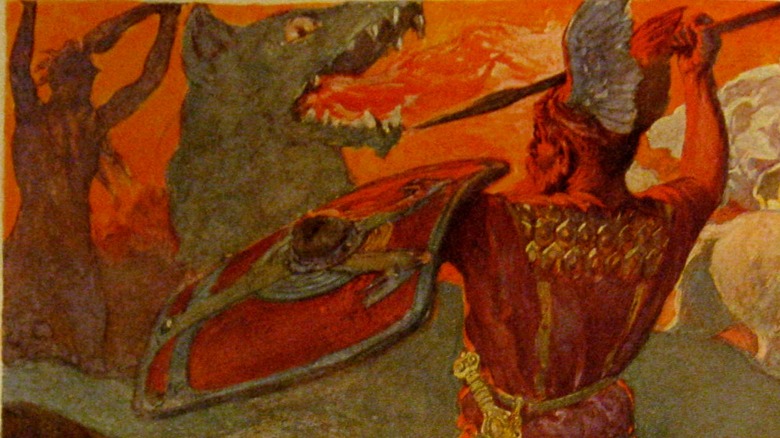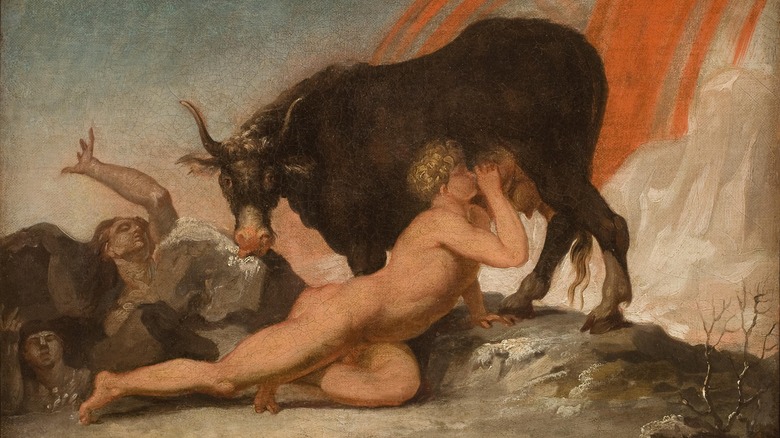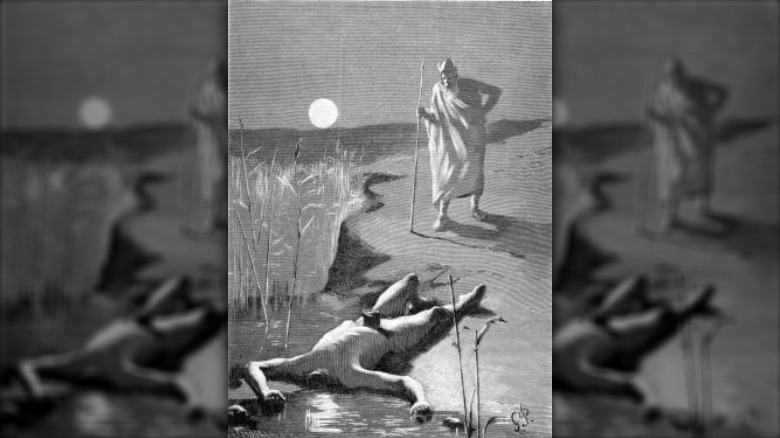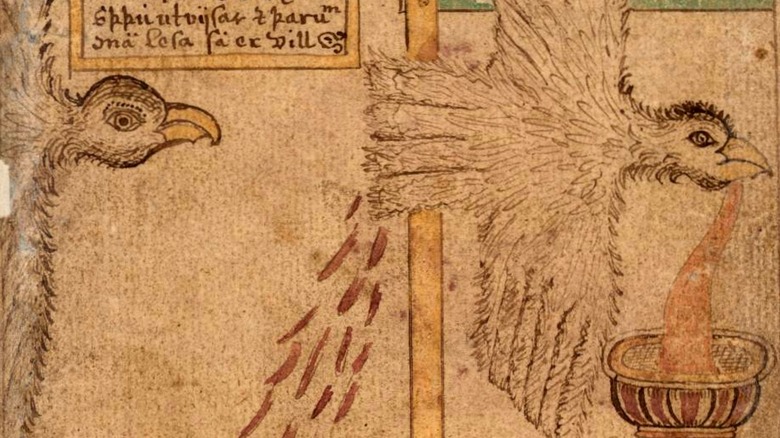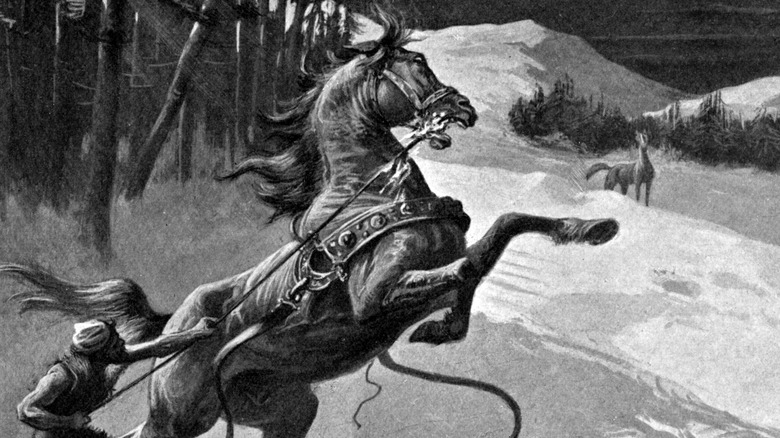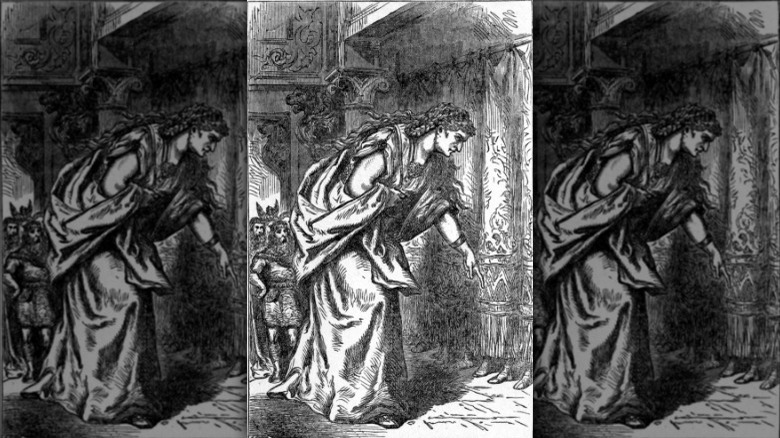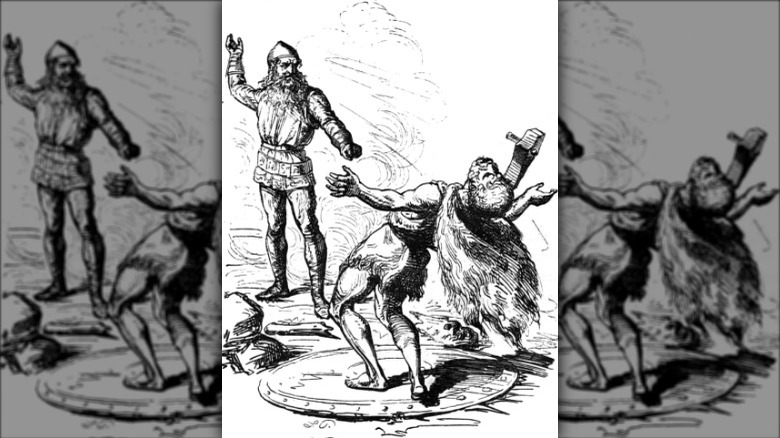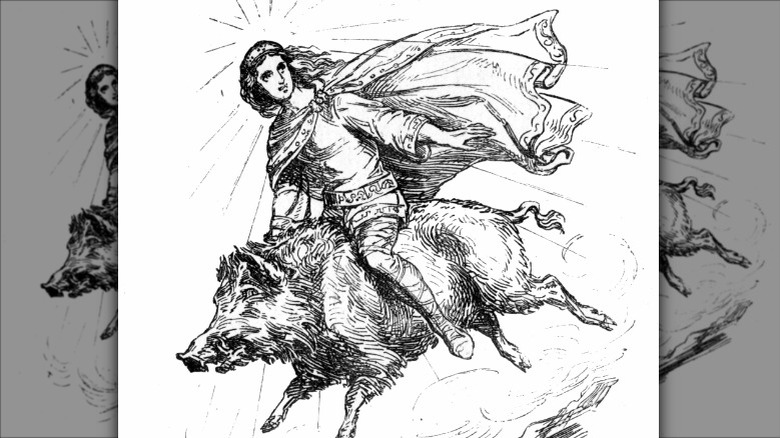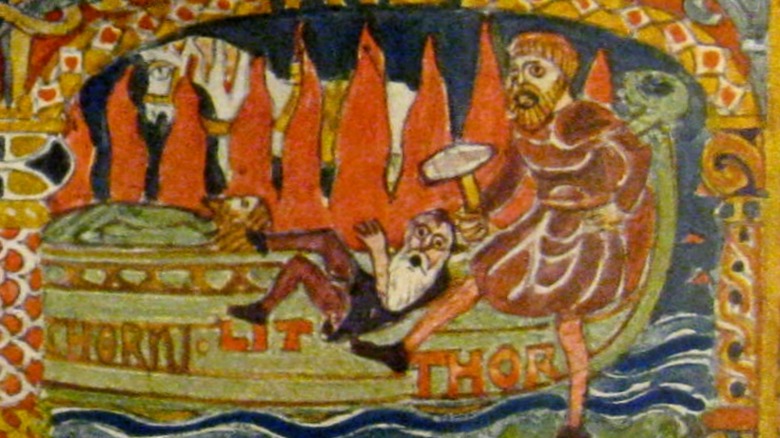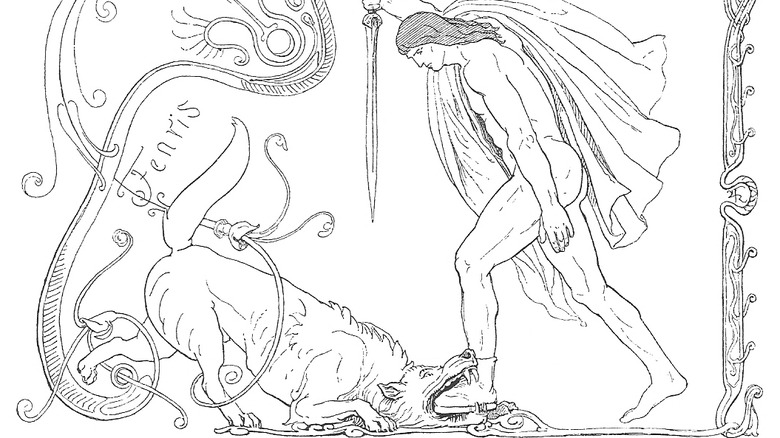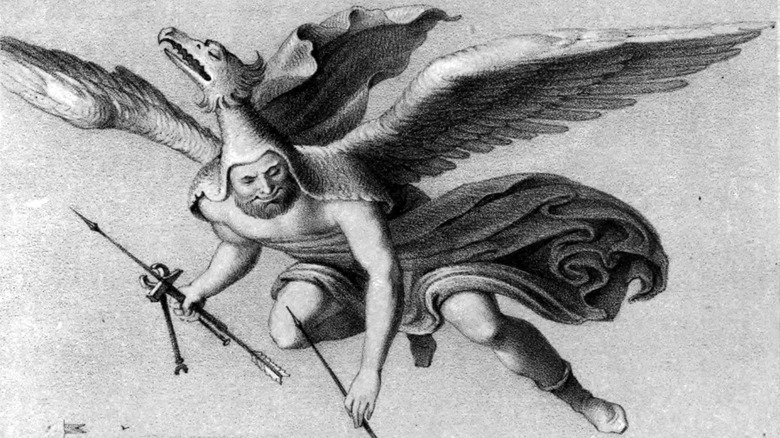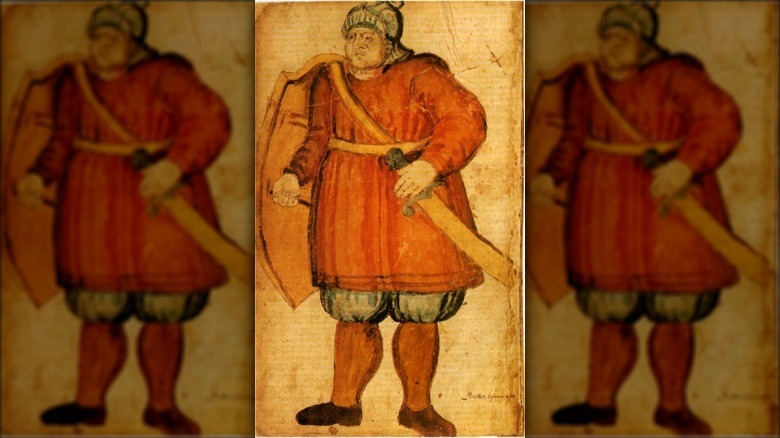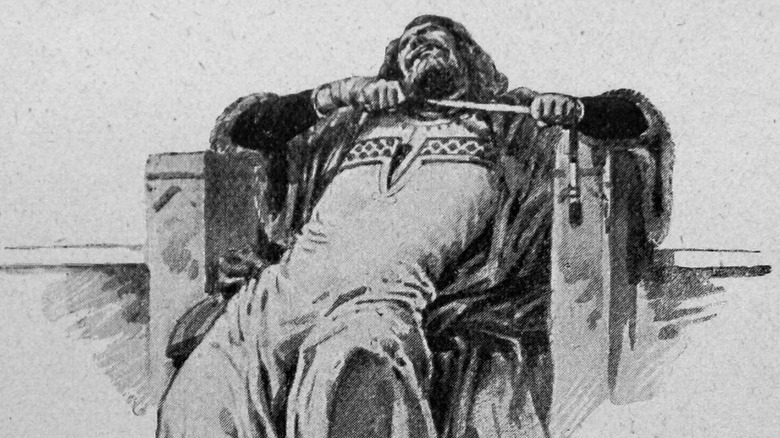The Wildest Stories From Norse Mythology
Thanks to the popularity of media such as Marvel's "Thor" movies and video games like "God of War: Ragnarok," English-speaking audiences are becoming increasingly familiar with ancient Norse mythology, the cycle of stories repeated by various Scandinavian nations and eventually written down by the 12th-century Icelandic writer Snorri Sturluson. But while casual fans of these popular franchises might be familiar with Thor, Loki, and Odin, and might even be able to name key locations like Asgard, Valhalla, and Bifrost, it doesn't take a particularly deep dive before getting into details from the Norse myths that are really, completely... weird.
It might not come as a surprise that the civilization that brought us the Vikings had extremely violent sacred tales given the civilization's reputation, but here's a look at some stories of the Old Norse that include talking severed heads, walking spit creatures, dudes giving birth to horses, and history's toughest shoe.
Creating the cosmos from a corpse
Viewers of Marvel's Thor films will know that the Norse cosmology is made up of nine different realms where different beings such as humans, the gods, giants, elves, and other creatures — with names like Midgard, Asgard, Jotunheim, and Alfheim — live. What the movies might not tell you is the extremely strange and kind of gross story of the creation of these Nine Realms and their respective inhabitants. According to Norse Mythology for Smart People, in the beginning, all that existed was a yawning void called Ginnungagap, which stretched between Muspelheim, the realm of fire, and Niflheim, the realm of ice. Eventually, however, the heat of Muspelheim stretched across the primordial gap and began to melt the ice. Out of the melting ice emerged Ymir, an intersex giant who asexually produced giants from the sweat of his legs and armpits.
As the ice continued to melt, a cow emerged whose milk nourished Ymir and who licked away at the ice, uncovering more beings, including the first god Buri, whose son Bor would father the three brothers Odin, Vili, and Ve. The three sons of Bor killed Ymir and shaped the cosmos from his dead body: Blood became oceans, skin became soil, brains became clouds, and so on. While humans were later made from "pieces of driftwood" the gods found, they had it better than dwarves, who were made from the maggots in Ymir's rotting flesh.
Wisdom from a severed head
While the most famous gods of Norse myth — like Thor, Odin, and Loki — come from the realm of Asgard and are known as Aesir (although technically Loki is half-giant), they aren't the only gods on the old World Tree. As Mythopedia explains, besides the Aesir of Asgard, there were also the Vanir gods of Vanaheim, who were earthier and more magical than the sky warriors of Asgard. As you might expect, with two groups of powerful gods out there, the two realms eventually had a war, which Norse Mythology for Smart People explains was largely the result of the Aesir being jealous of the magical abilities of Freya, one of the Vanir.
To make a long story short, when the war ended and a truce was forged, the two divine tribes secured the peace by each sending hostages to the other realm. Freya, her brother Freyr, and Njord of the Vanir went to live in Asgard, while the Aesir sent Hoenir and Mimir. The Vanir believed that Hoenir was a wise counselor, but soon grew frustrated with his bad advice. Thinking they had been cheated, they cut off Mimir's head and sent it back to Asgard, not realizing he was the actual smart one that had been telling Hoenir what to say when the Vanir gods thought he was smart. Odin used magic herbs to revive Mimir's severed head and used his invaluable advice for the rest of time.
Inspiration from a spit-man's blood
The exchange of hostages wasn't the only ceremonial sign of the end of the Aesir-Vanir War. As Encyclopedia Mythica explains, the two tribes of gods marked their shared peace by all lining up and spitting into a pot for some reason. Deciding that such a mess of god-spit was too good to waste, they took the bucketful of saliva and shaped it into a man, whom they named Kvasir. As you might expect, this spit-man was of course the wisest being in all the Nine Realms. There was no question he couldn't answer, and he traveled the world up and down sharing his knowledge. But as smart as he was, he didn't foresee that the invitation from the dwarf brothers Fjalarr and Galarr was a trap: The two dwarves murdered him, poured his blood into a kettle, added honey, and made mead from the spit-man's life juices.
This mead was known as the "mead of poetry" because anyone who drank it became either a poet or a scholar. Through a long and strange series of events that includes the dwarves going on a murder spree and Odin tricking nine guys into killing each other with scythes, shape-shifting into a snake, and seducing a giantess, Odin drank the mead and flew back to Asgard, where he vomited it into his own containers so that he might dispense its wisdom to human scholars and poets as he saw fit.
Loki mothers a horse
Loki, the shape-shifting trickster god of the Aesir, is something of an ambiguous figure in Norse mythology. Sometimes he's basically Thor's sidekick, other times he's actively killing other gods for a laugh. One thing that's clear, though, is that he is the father of many of the greatest monsters in all of Norse mythology. Mythopedia lists among his children with his giantess mistress Angrboda the world serpent Jörmungandr, who would eventually kill Thor; Fenrir, the enormous wolf that would kill Odin at the end of time; and Hel, ruler of the realm of the dead that bore her name. But in addition to being a father to these monstrous creatures, you might not know that Loki, a father to many monster children, was also the mother to one notable magic beast.
As Mythopedia says, after the war with the Vanir left Asgard in ruins, the gods hired a giant to build impregnable walls around their city, promising he could marry Freya if he finished before the beginning of summer (thinking, of course, that this was impossible). But when it seemed like he might actually do it, Loki transformed into a sexy mare in heat and lured the giant's horse away to slow his work down. While this distraction (kind of) worked, Horse-Loki also ended up pregnant by the giant's horse, and he gave birth to Sleipnir, the eight-legged horse that Odin would take as his own.
Loki does anything for a laugh
Another example of the great lengths that Loki was willing to go to on behalf of Asgard is the story of the giantess Skadi. As Norse Mythology for Smart People explains, the goddess of beauty Idun had been kidnapped by the giant Thjazi (with Loki's help) and rescued by the Aesir (with Loki's help). During the rescue effort, Thjazi was burnt to death by the gods, who had built a giant pyre as a trap. The gods were celebrating the safe return of Idun when suddenly Thjazi's daughter Skadi burst into the hall seeking vengeance for her father. The gods were able to calm her down a little by suggesting they could make reparations for her loss rather than spilling each other's blood.
Among other gifts, Skadi was allowed to marry a god of her choice, but she had to — for some reason — pick based on just their legs. She picked the sexiest pair, assuming these belonged to Balder, but they turned out to be the sweet gams of Njord, the sea god with whom she shared what turned out to be a very brief marriage.
Another condition, however, was that the gods had to make her laugh. Everyone else failed until Loki had the bright idea to tie his own testicles to a goat and engage in a game of tug of war, which he lost, giving Skadi her first laugh since her father's death.
Thor cracks two skulls, including his own
You can't have a list of wild Norse legends without some stories about Thor, who once disguised himself as a bride to recover his stolen hammer and wrestled the concept of old age itself into near submission. Many stories about the thunder god focus on his formidable strength and equally formidable temper. The tale of his duel with the giant Hrungnir is no exception. As the Encyclopedia Mythica explains, one day Thor was off hunting trolls and his father Odin decided it was a good idea to go taunt a giant. This giant, Hrungnir, chased him back to Asgard, where he threatened to destroy the city and kill all the gods. The gods, more annoyed than afraid, called on Thor to come and take care of the loudmouthed giant.
Thor came and challenged Hrungnir to a fight, and the two met on the field of battle with Thor brandishing his hammer Mjöllnir and Hrungnir wielding a giant whetstone. Thor threw his hammer like a bolt of lightning, and Hrungnir hurled his whetstone. The two objects struck each other in midair, and the hammer turned the whetstone into pebbles before it "smashed [Hrungnir's] skull into small crumbs." A shard of the whetstone became lodged in Thor's forehead. Then, the dead giant's leg fell upon Thor's neck and was so heavy that no one could lift it except for Thor's toddler son Magni.
Freyr dooms himself for love
According to the Encyclopedia Mythica, Freya's brother Freyr was one of the Vanir who came to live in Asgard following the war of the gods. He was the god of agriculture, fertility, and nice weather, and had a number of notable magic items to his name, including the ship Skíðblaðnir, which always found a favorable wind and could be folded up and put in your pocket, and the golden-bristled boar Gullinbursti, which he rode like a horse on air and water as well as land. Another possession that turned out to be a big deal was a magic sword that was capable of fighting giants all by itself. Unfortunately, this sword was so cool that when Freyr fell in love with the giantess Gerðr, she only agreed to meet with him if he gave her his giant-slaying sword. The besotted Freyr agreed, which turned out to be the biggest mistake of his life.
First, when Freyr found himself face to face with the giant Beli, he had no sword to use against him and had to resort to slaying his foe with a reindeer's antler. But while he emerged from that confrontation unscathed, becoming known as "the bright slayer of Beli," he won't be so lucky at the end of the world: When Ragnarök comes, Freyr will find himself unarmed in the battle against the fire giant Surtr, who will easily crush the swordless god.
Thor punts a dwarf at a funeral
One of the most famous stories in all of Norse mythology is that of the death of Baldur, which — as Norse Mythology for Smart People explains — began when Odin had a prophetic dream of his son's imminent doom and his wife Frigg went around extracting promises from every material in the universe that they would refuse to harm the universally beloved Baldur, god of light and beauty. But the problem is, she forgot to get a promise from the mistletoe plant, and so tricksy old Loki fashioned — you know, as a prank — an arrow out of mistletoe and had an unsuspecting blind god — you know, as a prank — hurl it at Baldur, killing him. The loss of the god of light from the world is then the first omen of the coming of Ragnarök. A hilarious prank.
But a detail from the story you might not know that is left out of many adaptations is that at Baldur's funeral, where the god's body was laid on a ship set ablaze and his wife Nanna, in grief, cast herself into the flames, a random dwarf named Litr — whose only appearance in all of the myth is this one moment — ran past Baldur's brother Thor, who punted him into the fire, where he burned to death. Thor's motivation for this is never explained.
The silent god's big boot
Speaking of Ragnarök, the Norse version of the end of everything sees the death of pretty much all the well-known gods. According to Norse Mythology for Smart People, Odin will be devoured by the wolf Fenrir, and Thor and the world serpent Jormungandr will kill each other, as will Freyr and Surtr. But one fascinating and enigmatic figure among the Aesir fighting at the end of the world is one of the few that survives: Vidar, the silent god. The few details we know about him include that he is the son of Odin and the giantess Gríðr; he is the strongest god after Thor; he will avenge the death of Odin; and he will inhabit the charred ruins of Asgard.
That on its own is not very interesting, but what is pretty incredible is the means by which Vidar will avenge Odin's death: a very big shoe. You see after Fenrir eats Odin alive, Vidar will rush in, grab the wolf's jaws, step on his lower jaw, and push until it cracks and the wolf dies. But Fenrir's jaws are so sharp that this can only be done if Vidar is wearing the world's thickest-soled shoe, which has been crafted from every bit of scrap shoe leather that has ever been thrown away. For this reason, the Norse people were always sure to throw out their shoe scraps to aid Vidar in his quest for vengeance.
Wayland's revenge
The stories of the gods as recorded in the collected texts known as the Eddas aren't the only sources of wild tales of Scandinavian culture. Norse literature is also full of legendary sagas of humans (sometimes even historical ones) and their encounters with gods and monsters, some of which will have your head spinning. One such story is that of Völundr the smith often rendered in English as Wayland or Weland. According to Britannica, Wayland's incredible skill as a blacksmith led to his being renowned in not only Norse but also German and Anglo-Saxon legends, including "Beowulf."
As the Encyclopedia Mythica explains, Wayland was married to a valkyrie, but when she went missing, he stayed home and crafted hundreds of gold rings while awaiting her return. This drew the attention of the wicked king Níðuðr, who had his men kidnap Wayland, cripple him, and force him to work in the king's forge. When the king's continued greed made him careless, Weyland was able to cut off the heads of the king's sons, turning their skulls into silver-plated goblets and their teeth into jewelry, which he gave to the king and his wife. He also assaulted and impregnated the king's daughter. Considering his vengeance complete, Wayland then strapped on a pair of golden wings he made for himself and flew away, never to be seen again.
Grettir's zombie Christmas
According to Britannica, one of the best of the Norse sagas is the 14th-century life story of the outlaw Grettir, who, despite coming from a good family and being strong and brave, ends up spending most of his life outside of the law and fighting innumerable foes, human and monster alike. While the saga is a relatively long one and features many encounters with berserkers, trolls, and even regular people, perhaps Grettir's most famous fight is his Christmas battle against the walking dead.
As the Historian's Hut recounts, a farmer who discovered that his farm was haunted hired a very large, very strong shepherd named Glam to protect his livestock from the supernatural. All went okay until the notoriously uncouth Glam decided to skip out on Christmas Eve mass, which left his body and soul vulnerable to the undead. Glam himself did not rest in peace but instead clawed his way out of his grave as a draugr, which is kind of a ghost-zombie hybrid. After the undead Glam made no end of trouble on the farm, the farmer requested the help of Grettir, who had killed a draugr before. The two faced off and Grettir eventually bested the huge beast, but the draugr used his dying breath to curse Gretti. He would have bad luck for all his days and be eternally afraid of the dark.
The morbid life of Hadingus
One of the darkest legends from Norse pseudo-history comes in the life of the Danish king Hadingus, as recorded in the epic 12th-century work "Gesta Danorum" ("Deeds of the Danes") by Saxo Grammaticus. As Medievalists explains, Hadingus was the son of the Danish king Gram and the kidnapped Finnish princess Signe. The killing of Gram in revenge for this kidnapping leaves Hadingus a baby forced into exile in Sweden, where he is raised by the giant Vagnhofth and his daughter Harthgrepa. Harthgrepa, despite being Hadingus's foster mother who nursed him as an infant, convinces him to marry her, and the two travel together. On these travels, they come across a dead man's hut, where Harthgrepa does some necromancy and the man's spirit predicts that she will be torn to pieces by a giant ghost hand, which soon comes true.
Later, at his second wedding, to a princess he rescues from giants, Hadingus follows a strange woman to the Underworld. There he learns that the dead are condemned to repeat their actions in life. Hadding spends his life fighting wars until rumors of his death begin to spread. The Swedish king comes to mourn his death with an enormous jar of ale, which he accidentally falls into and drowns. Out of respect for such a serious loss at an unnecessary funeral, Hadding hangs himself in front of all his people so the funeral wasn't a waste.
